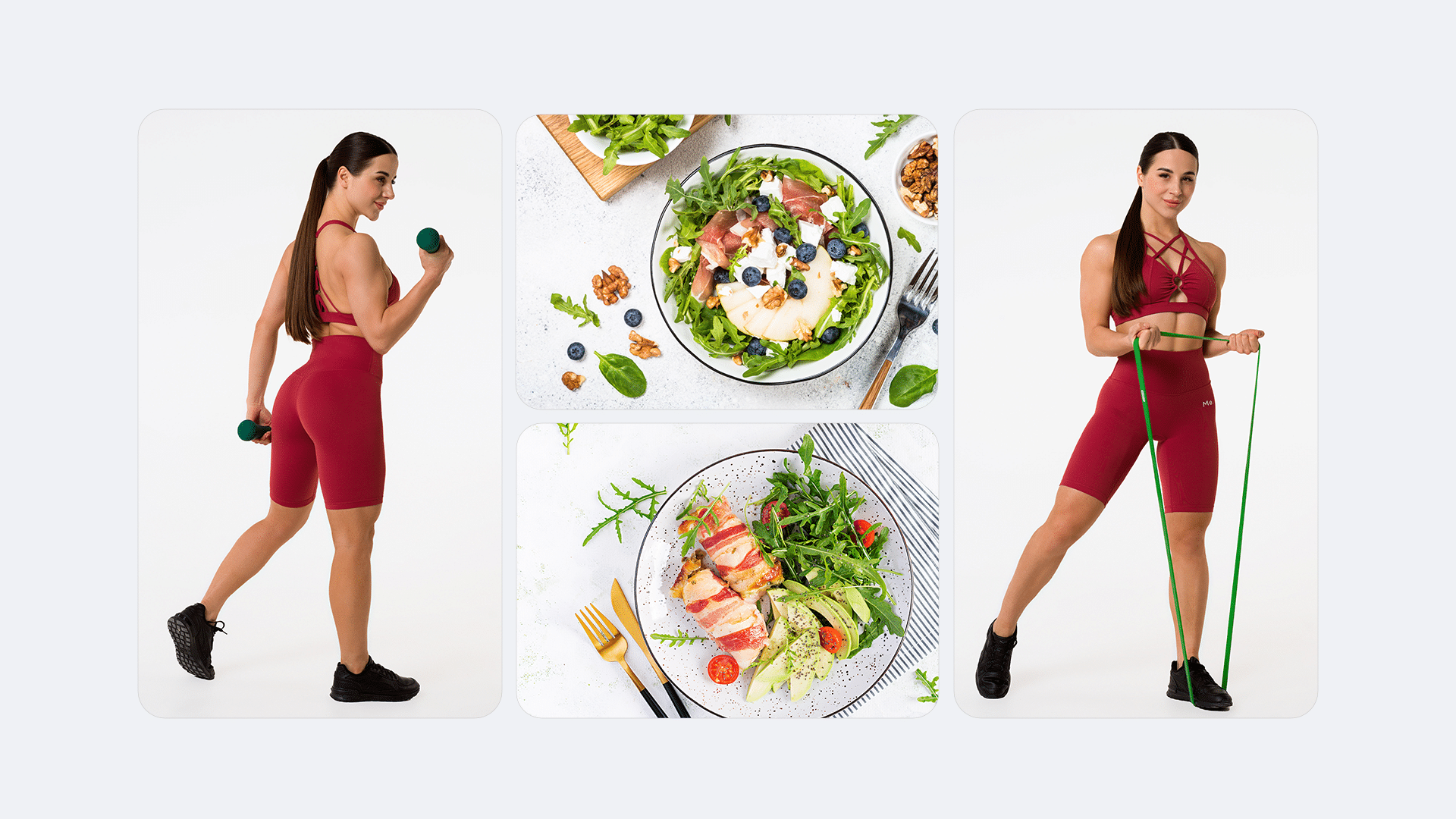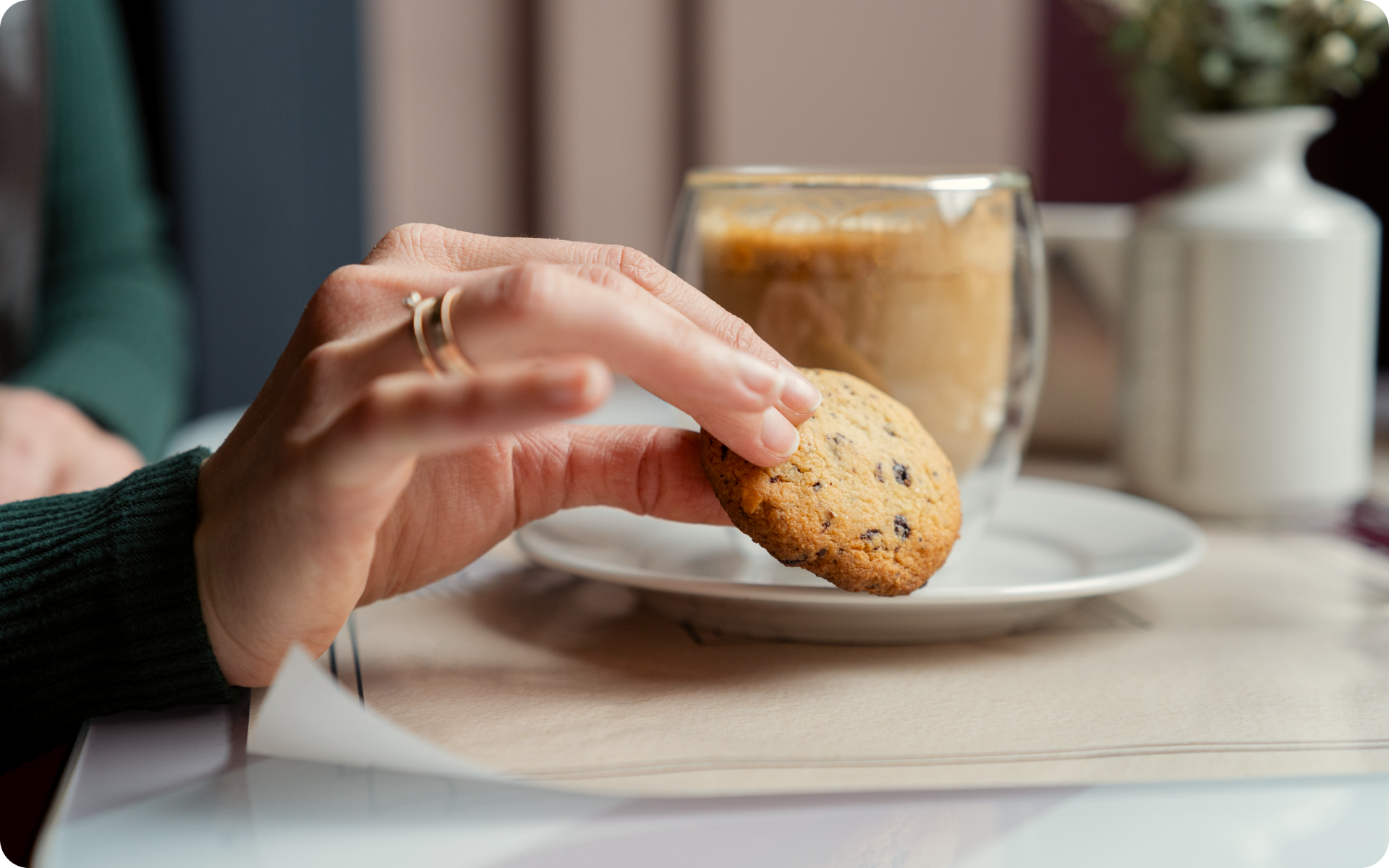There are many forms of fasting and each has its unique rhythm and benefits. Examples include the 16/8 method, Eat-Stop-Eat, the 5:2 diet, and alternate-day fasting. With each one, you may experience varied effects on your health and well-being (7).
Knowing what to eat to support your goals can be overwhelming for beginners. You need to ensure you get enough nutrients while keeping your calorie intake within a set limit. Also, it’s crucial to consume foods that enhance your energy levels, rather than those that leave you feeling depleted.
However, if you navigate this process correctly, you may reap the benefits of improved metabolism, reduced inflammation, and weight loss. You may even discover a new appreciation for food and its nourishing qualities.
To help you get started, we’ve created some sample meal plans for every stage of your intermittent fasting journey.
How Do You Start Intermittent Fasting for Beginners?
To start intermittent fasting, you need to decide on the fasting method that best suits your lifestyle and goals. Then, you should ease into it gradually and listen to your body’s signals as you go along.
For beginners, we recommend starting with the 16/8 method, which involves fasting for 16 hours and eating within an eight-hour window each day. This method is easy to follow as it aligns with our natural circadian rhythm and allows for flexibility in meal timing (3).
In fact, you’ll sometimes hear it called the ‘golden standard’ of intermittent fasting. But you shouldn’t let that intimidate you – it’s an achievable goal and a great place to start. You can work your way up to 16 hours of fasting by starting with 12, increasing to 14, and then reaching 16.
It may initially seem as if there’s just too much to learn about what you should and shouldn’t do. You may even wonder if you’ll be able to stick to a fasting routine.
We’ll break down the basics below:
- Ask yourself why you want to fast. What do you hope to achieve? Understanding your motivations will help you stay committed.
- Consider your lifestyle. Are there days of the week or times of day when you know you’ll struggle to stick to your fasting window? Plan accordingly.
- Prepare your kitchen and pantry. Get rid of ultra-processed foods, stock up on healthy options, and plan for meals that align with your chosen method.
- Know what breaks your fast. Black coffee, unsweetened tea, and water are generally safe to consume during the fasting period.
- Take note of how you feel, your energy levels, and weight changes. This will help you remain motivated and make adjustments to meals as needed.
- Have a plan for progression. Once you’ve mastered the 16/8 method, you can consider exploring other fasting methods to continue challenging your body and reaping new benefits, or stick with what works for you.
- Don’t overdo it. Intermittent fasting is not meant to be a strict diet or a punishment for indulging in your favorite foods.
This is just a quick run-through of some of the things you should keep in mind as a beginner.
Our Intermittent Fasting Guide has a more detailed breakdown of the different methods, tips for staying motivated, and delicious meal ideas to support your fasting journey.
You can also cut through the clutter and get started right away after reading this blog: Rules of Intermittent Fasting.
What Foods Should I Eat on 16/8 Intermittent Fasting?
The foods you eat on 16/8 intermittent fasting are similar to those you would eat on any other form of IF. They’re nutrient-dense whole foods that provide sustained energy and support your body’s needs, including:
- Proteins: High-quality proteins such as lean meats, poultry, fish, eggs, and plant-based proteins such as lentils, chickpeas, and tofu. They help maintain muscle mass and keep you satiated (8).
- Healthy Fats: Foods such as avocados, nuts, seeds, and olive oil. They provide long-lasting energy and are essential for the absorption of fat-soluble vitamins (4).
- Complex Carbohydrates: Whole grains such as brown rice, quinoa, and oats, and starchy vegetables such as sweet potatoes and beets. They provide a slow release of energy, which helps you maintain your energy levels throughout your fasting period (2).
- Fruits and Vegetables: A wide range of colorful fruits and vegetables should be included in your diet for their high fiber and antioxidant content. They’re low in calories and high in nutrients, which makes them an excellent choice for weight management.
- Fermented Foods: Foods such as yogurt, kefir, sauerkraut, and kimchi provide probiotics that support gut health, a crucial factor in overall wellness (5).
- Hydrating Foods: Foods such as cucumbers, watermelon, oranges, and strawberries contain high amounts of water and can help keep you hydrated (1).
What Should My First Meal Be When Intermittent Fasting?
Your first meal when intermittent fasting, that is, when you break a fast, should be light, nutritious, and ease your digestive system back into action. Depending on how long your fast has been, you may want to start with liquids or easily digestible foods. Here are some ideas for your first meal:
For shorter fasts (less than 24 hours):
- Smoothies: A fruit and vegetable smoothie with added protein powder or Greek yogurt for a balanced meal.
- Soups: Vegetable-based soups with legumes, chicken, or fish for added protein and fiber.
- Eggs: Scrambled eggs with spinach, mushrooms, and avocado for healthy fats and nutrients.
For longer fasts (24 hours or more):
- Bone Broth: A nutrient-dense broth made from simmering bones and vegetables for a light and easily digestible meal.
- Vegetable Broth: A nutrient-packed broth made from simmering a variety of vegetables, herbs, and spices.
- Fermented Foods: Yogurt, kefir, or sauerkraut are options that provide probiotics and support gut health after an extended fast.
What Should I Eat During 7 Days of Intermittent Fasting?
Your seven-day meal plan for intermittent fasting will contain foods such as lean proteins, healthy fats, complex carbohydrates, fruits and vegetables, fermented foods, and hydrating foods.
Here’s an example of a seven-day meal plan for the 16/8 method:
Day 1
During the Fasting Window:
- Drink plenty of water throughout the day
- Black coffee or tea (no sugar or cream)
During the Eating Window:
- Breakfast: Avocado and egg toast on whole-grain bread
- Lunch: Grilled chicken salad with lots of colorful vegetables
- Snack: A handful of mixed nuts
- Dinner: Baked salmon with quinoa and steamed broccoli
Day 2
During the Fasting Window:
- Drink plenty of water throughout the day
- Black coffee or tea (no sugar or cream)
During the Eating Window:
- Breakfast: Greek yogurt with berries and a drizzle of honey
- Lunch: Chickpea and vegetable stir fry
- Snack: An apple with almond butter
- Dinner: Lean beef steak with sweet potatoes and greens
Day 3
During the Fasting Window:
- Drink plenty of water throughout the day
- Black coffee or tea (no sugar or cream)
During the Eating Window:
- Breakfast: Quinoa porridge with almond milk and fresh fruits
- Lunch: Tuna salad with whole-grain bread
- Snack: A cup of Greek yogurt with a handful of mixed berries
- Dinner: Grilled tofu with mixed vegetables and brown rice
Day 4
During the Fasting Window:
- Drink plenty of water throughout the day
- Black coffee or tea (no sugar or cream)
During the Eating Window:
- Breakfast: Scrambled eggs with vegetables and a slice of whole-grain toast
- Lunch: Quinoa salad with lots of fresh vegetables
- Snack: A banana and a handful of nuts
- Dinner: Baked chicken breast with plenty of steamed vegetables
Day 5
During the Fasting Window
- Drink plenty of water throughout the day
- Black coffee or tea (no sugar or cream)
During the Eating Window
- Breakfast: Protein smoothie with spinach, banana, and almond butter
- Lunch: Lentil soup with a side salad
- Snack: An orange and a handful of almonds
- Dinner: Grilled fish with a side of sweet potato mash and broccoli
Day 6
During the Fasting Window:
- Drink plenty of water throughout the day
- Black coffee or tea (no sugar or cream)
During the Eating Window:
- Breakfast: Overnight oats with fresh berries and a drizzle of honey
- Lunch: Turkey and vegetable wrap with a side of fruit
- Snack: A cup of Greek yogurt with a sprinkle of granola
- Dinner: Stir-fried shrimp with brown rice and mixed vegetables
Day 7
During the Fasting Window:
- Drink plenty of water throughout the day
- Black coffee or tea (no sugar or cream)
During the Eating Window:
- Breakfast: Avocado and tomato on whole-grain toast
- Lunch: Chicken and vegetable soup with a slice of whole-grain bread
- Snack: A pear and a handful of walnuts
- Dinner: Baked salmon with quinoa and a side of mixed vegetables
IF Meal Plans for Different Needs
As you progress on your intermittent fasting journey, you may want to switch up your meal plans to better suit your body’s needs. Here are some ideas for meal plans for different stages and needs:
Beginner Intermittent Fasting Meal Plan for Weight Loss
People who are new to intermittent fasting may struggle with hunger pangs, energy dips, or changes in mood. Therefore, it’s important to choose foods that are high in protein and fiber to keep you feeling full. A diet that is rich in lean protein, whole grains, fruits, and vegetables is ideal for weight loss (9). Your portion sizes will be dependent on your individual calorie goal.
One-Day Meal Plan (eat within 8 hours)
- Breakfast: Overnight oats with almond milk, chia seeds, and a handful of berries.
- Lunch: Grilled turkey with quinoa and a side of mixed vegetables.
- Dinner: Baked salmon with a side of brown rice and asparagus.
Beginner Intermittent Fasting Meal Plan for Females
Women who are new to intermittent fasting must ensure that they still get enough calcium and iron. Consuming nutrient-dense foods is key, particularly those that are rich in iron, calcium, and vitamin D.
One-Day Meal Plan (eat within 8 hours)
- Breakfast: Greek yogurt with a sprinkle of granola and a handful of blueberries.
- Lunch: Spinach salad with grilled chicken, cherry tomatoes, and an olive oil dressing.
- Dinner: Quinoa-stuffed bell peppers with a side of steamed broccoli.
Beginner Intermittent Fasting Meal Plan for Males
Men who are starting on intermittent fasting may require more calories than women, particularly if they’re maintaining a regular exercise routine. Their diet should be focused on lean proteins, complex carbohydrates, and healthy fats to support muscle growth and energy levels.
One-Day Meal Plan (eat within 8 hours)
- Breakfast: Scrambled eggs with whole-grain toast and a side of avocado.
- Lunch: Beef stir fry with brown rice and a variety of vegetables.
- Dinner: Grilled chicken with sweet potato and a side of green beans.
Beginner Intermittent Fasting Meal Plan for Seniors
Intermittent fasting can also benefit older adults if they don’t have any medical conditions and they’re not taking any medications that would make it unsafe for them, but it’s important to choose foods that are easy to digest and provide essential nutrients. Foods that are rich in protein, healthy fats, and fiber are ideal for seniors.
One-Day Meal Plan (eat within 8 hours)
- Breakfast: Poached eggs on whole-grain toast with a side of fruit.
- Lunch: Lentil soup with a slice of whole-grain bread.
- Dinner: Baked fish with a side salad and quinoa.
Advanced Intermittent Fasting Meal Plan for Muscle Gain
Intermittent fasting can be tailored to support muscle growth and strength gains. Here’s an example of a meal plan that prioritizes protein intake during the eating window:
One-Day Meal Plan (eat within 8 hours)
- Breakfast: Protein shake with almond milk, banana, and peanut butter.
- Lunch: Grilled chicken breast with brown rice and mixed vegetables.
- Dinner: Beef stir fry with quinoa and a side of roasted sweet potatoes.
Keto Intermittent Fasting Meal Plan for Weight Loss
Combining intermittent fasting with a ketogenic diet may further enhance weight loss results. This involves consuming high-fat, moderate-protein, and low-carb meals during the eating window.
One-Day Meal Plan (eat within 8 hours)
- Breakfast: Keto-friendly avocado toast with scrambled eggs.
- Lunch: Grilled salmon with cauliflower rice and steamed broccoli.
- Dinner: Baked chicken thighs with a side salad topped with olive oil dressing.
FAQs
Is 11 AM to 7 PM intermittent fasting?
Yes, the time window from 11 AM to 7 PM can definitely be used for intermittent fasting. This is a typical example of the 16/8 method, where you fast for 16 hours and limit your eating to an eight-hour window.
Do you skip breakfast or dinner during intermittent fasting 16/8?
Whether you skip breakfast or dinner during the 16/8 intermittent fasting method is dependent on your personal preference and lifestyle. Some people prefer to skip breakfast and start eating in the early afternoon, whereas others prefer to eat breakfast and finish their dinner early. The important thing is to maintain the fasting window of 16 hours.
How many calories should you eat on a 16/8 fast?
There isn’t a set number of calories you should aim for during a 16/8 fast. The goal should be to eat a balanced diet that keeps you satiated during your fasting period without exceeding your daily caloric needs.
It’s important to focus on nutrient-dense foods and avoid excessive calorie intake. However, as a rough guideline, many people aim for around 500-600 calories less than their typical intake for weight loss.
When should your last meal be when intermittent fasting?
The timing of your last meal during intermittent fasting is dependent on the eating window you’ve set. For example, if you’re following the 16/8 fasting method and your eating window is from 11 AM to 7 PM, your last meal should be no later than 7 PM, which is when you start your 16-hour fasting period.
The Bottom Line
A beginner’s fasting meal plan should prioritize nutrient-dense foods to support your health and well-being. As you progress with intermittent fasting, you can adjust your meals to better suit your lifestyle and goals.
DISCLAIMER:
This article is intended for general informational purposes only and does not serve to address individual circumstances. It is not a substitute for professional advice or help and should not be relied on for making any kind of decision-making. Any action taken as a direct or indirect result of the information in this article is entirely at your own risk and is your sole responsibility.
BetterMe, its content staff, and its medical advisors accept no responsibility for inaccuracies, errors, misstatements, inconsistencies, or omissions and specifically disclaim any liability, loss or risk, personal, professional or otherwise, which may be incurred as a consequence, directly or indirectly, of the use and/or application of any content.
You should always seek the advice of your physician or other qualified health provider with any questions you may have regarding a medical condition or your specific situation. Never disregard professional medical advice or delay seeking it because of BetterMe content. If you suspect or think you may have a medical emergency, call your doctor.
SOURCES:
- 15 foods that help you stay hydrated (2022,uclahealth.org)
- Complex carbohydrates (2022,medlineplus.gov)
- Effects of eight weeks of time-restricted feeding (16/8) on basal metabolism, maximal strength, body composition, inflammation, and cardiovascular risk factors in resistance-trained males (2016,nih.gov)
- Fat-Soluble Vitamins (1989,nih.gov)
- Fermented Foods, Health and the Gut Microbiome (2016,nih.gov)
- Health Benefits of Dietary Whole Grains: An Umbrella Review of Meta-analyses (2017,nih.gov)
- Intermittent Fasting: How It Works and 4 Types Explained (2022,clevelandclinic.org)
- Intermittent fasting and protein pacing are superior to caloric restriction for weight and visceral fat loss (2023,nih.gov)
- Optimal Diet Strategies for Weight Loss and Weight Loss Maintenance (2021,nih.gov)












